Colour Isn’t Everything
Many people walk into a jewellery store convinced that a diamond has to be pure white. But “white” is more complicated than it sounds. Diamonds are graded from D to Z, with D being completely colourless and Z showing noticeable yellow or brown hints.
I remember helping a friend pick an engagement ring once. She was obsessed with getting a D-colour diamond, convinced it would sparkle the most. Funny enough, when we compared it with a G-colour diamond that had a far better cut, the G-colour stone looked livelier, more playful even. Ever notice how a stone can look one way in the shop and totally different under daylight? It’s wild.
Brilliance Over Colour
Brilliance is what really makes a diamond special. It’s the way light dances inside it before bouncing back to your eyes. Think of it as the diamond’s personality. A stone with a tiny hint of warmth but an excellent cut can often outshine a colourless diamond with a mediocre cut.
When shopping, don’t get lost in charts. Tilt the diamond slightly, watch it from different angles, and see how it reacts in sunlight, indoor lamps, and even candlelight. I’ve often noticed diamonds that seemed flat in the store suddenly sparkle like mad in natural light. That’s brilliance. And let’s be honest, isn’t that what we’re really chasing?
Cut Makes the Difference
I cannot stress this enough: cut is everything. A poorly cut diamond, even if colourless, can look surprisingly dull. I once saw an E-colour diamond that looked a bit flat, while a smaller H-colour stone practically glowed. The right cut makes a diamond feel alive.
Good symmetry, proper proportions, and precise angles mean light travels perfectly inside the stone. When picking a diamond, hold it, tilt it, rotate it slowly. Watch for that sparkle that makes you smile, maybe even gasp a little. You’ll know it when you see it.
Clarity Isn’t Always Critical
Clarity is about inclusions, the tiny imperfections inside a diamond. Many people think a flawless diamond is the only option. But here’s the secret: most inclusions are invisible to the naked eye. Unless you’re peering through a jeweller’s loupe, you probably won’t notice them at all.
I’ve seen customers skip over diamonds with minor inclusions, only to pick a bigger, poorly cut stone that looked flat. If you ask me, focus on brilliance and cut first. Clarity matters, but a small inclusion won’t ruin a sparkling diamond.
Size Isn’t Everything
Bigger isn’t automatically better. A large diamond with a mediocre cut can look dull, while a smaller, well-cut diamond can sparkle like crazy. I remember a customer hesitating over a slightly smaller stone. When we compared it to a bigger, poorly cut diamond, she couldn’t believe how much more lively the smaller one appeared. It’s funny how that works. Sometimes it’s better to pick the diamond that shines, not the one that’s bigger.
Tips for Choosing Brilliance
- Don’t focus solely on colour. Slightly warmer diamonds with perfect cuts often sparkle more than “white” ones with mediocre cuts.
- Prioritise cut. Seriously, it determines how alive a diamond looks.
- Check the stone in different lights. Sunlight, indoor lamps, candlelight—they all reveal different sides.
- Think about the setting. Metal colour and design can enhance or dull the sparkle.
- Trust your eyes. If it makes you pause and look twice, it’s probably a winner.
You May Also Like: Fashion vs. Fine Jewellery: The Complete Expert’s Guide
Conclusion
Picking a diamond isn’t about ticking boxes for colour, size, or even clarity. It’s about finding the stone that catches the light in a way that makes your heart skip a beat. Brilliance matters more than just whiteness. Focus on cut, reflection, and sparkle, and you’ll walk away with a diamond that truly comes alive.
Remember, a diamond is more than a purchase. It’s a memory, a story, and sometimes a little piece of magic that stays with you for decades. Don’t get lost in charts or grades. Trust your eyes, follow what makes you smile, and let the diamond’s brilliance speak for itself.

